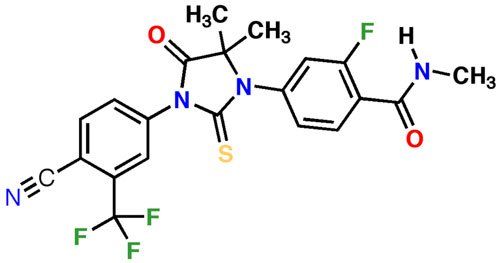Possible Biomarker for Enzalutamide in Prostate Cancer
Researchers have identified a potential biomarker that may confer inherent resistance to enzalutamide for patients with castration-resistant prostate cancer.
Chemical structure of enzalutamide

Men with metastatic castration-resistant prostate cancer (CRPC) now have several treatment options beyond chemotherapy. One is the oral agent enzalutamide, approved in August 2012 by the US Food and Drug Administration to treat men with metastatic CRPC after docetaxel treatment. Many men respond to the therapy, but some men have inherent resistance to the androgen receptor antagonist.
Now, researchers have identified a potential biomarker that may confer inherent resistance to enzalutamide. The marker, a variant form of the androgen receptor called AR-V7, can be detected in circulating tumor cells (CTCs) that can be obtained with a blood draw from patients prior to the start of the therapy. Those metastatic CRPC patients whose CTCs had AR-V7 had a worse response to enzalutamide compared with patients whose CTCs had no detectable AR-V7. These results were presented at the 2014 American Association for Cancer Research (AACR) Annual Meeting, held April 5–9, in San Diego.
“If validated by other groups, the presence of AR-V7 in CTCs or tumor biopsies from patients with CRPC could help to select patients for alternative treatments that do not rely on the androgen receptor axis, including chemotherapies,” said lead study author Emmanuel S. Antonarakis, MD, assistant professor of oncology at Johns Hopkins Sidney Kimmel Comprehensive Cancer Center in Baltimore, Maryland.
Thirty-one metastatic CRPC patients enrolled in the clinical trial had blood draws prior to the start of treatment, at peak response to the drug, and at disease progression. Twelve of the 31 (38.7%) patients had AR-V7 detectable in their CTCs prior to starting the enzalutamide regimen. These patients had earlier disease progression compared with patients who were not positive for AR-V7. The time to radiographic progression was 2.1 months in the AR-V7–positive patients compared with 6.1 months in those who had no detectable AR-V7 (P < .001). No AR-V7–positive patients achieved a prostate-specific antigen (PSA) response compared with AR-V7–negative patients (0% vs 52.6%, respectively; P = .004).
Testosterone and other hormones bind to the androgen receptor, activating growth and division pathways that drive prostate cancer. AR-V7 is a truncated version of the androgen receptor protein, found in the cytoplasm of prostate cells. This shortened version lacks the portion that binds testosterone and enzalutamide; instead AR-V7 is constitutively active even in the absence of androgens, fueling growth and cancer division.
According to Dr. Antonarakis, AR-V7 was discovered in 2007 as a marker of CRPC progression and is present in approximately 39% of enzalutamide-treated patients tested. “It’s not rare,” he added.
Even though AR-V7 results in continuous activation of the androgen receptor in animal models and human prostate cancer cell lines, it was not previously clear whether AR-V7 would confer resistance to enzalutamide.
According to the authors, before conducting a large-scale prospective trial to understand the utility of the AR-V7 marker to predict enzalutamide resistance, the test used to detect levels of AR-V7 RNA in CTCs needs to be certified in a Clinical Laboratory Improvement Amendments (CLIA) setting for quality control. “Once the AR-V7 assay is CLIA-certified, we plan to prospectively assess the utility of this test in future trials involving enzalutamide,” Antonarakis told Cancer Network. The researchers also plan to apply this analysis to large datasets from prospective enzalutamide trials that have previously been reported, if enough blood samples from patients are available.
A similar study evaluating the role of AR-V7 as a resistance biomarker of abiraterone acetate therapy is currently ongoing.
Whether AR-V7 levels change over time in response to therapy is also being evaluated.
“[This research] should also fuel the development of drugs that can target and inhibit the N-terminal domain of the androgen receptor, of which there are currently none in the clinic,” said Antonarakis.
Reference
1. Antonarakis ES, Lu C, Wang H, et al. Androgen receptor splice variant-7 predicts resistance to enzalutamide in patients with castration-resistant prostate cancer. American Association for Cancer Research Annual Meeting 2014; April 5–9, 2014; San Diego. Abstr 2910.